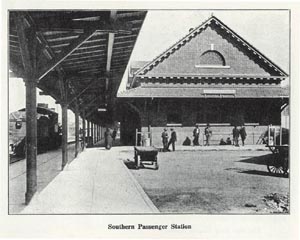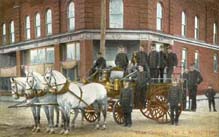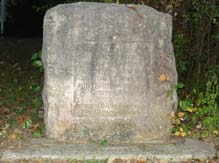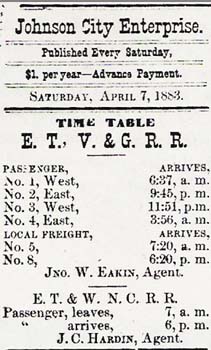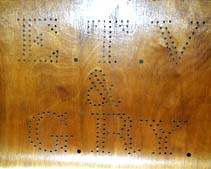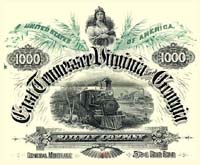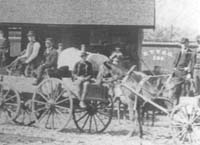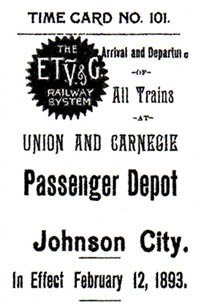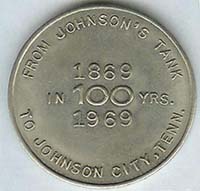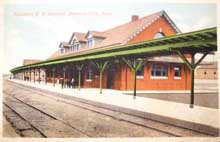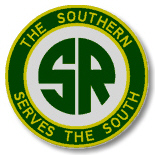The first railroad to come through Eastern Tennessee was the East Tennessee and Virginia Railroad which was chartered in 1849. Many families along the proposed route bought the initial stock in the railroad, pledging their personal fortunes as collateral. Construction began in 1855 with one section of the railway beginning in Bristol and another in Knoxville. Key elected officials and political leaders such as Tennessee Governor Andrew Johnson (a future U.S. President) and Landon Carter Haynes (a future Confederate Senator) were strong supporters of railway development in Northeast Tennessee.
Realizing the potential of the new railroad, Henry
Johnson bought property at the junction of the proposed rail line and
the stagecoach route between Elizabethton and Jonesborough in 1854. He
built a store, depot, post office, and residence all on his half-acre
lot purchased from Abram Jobe for $50. Trains stopped to take on water
for steam engines and the village became known as "Johnson's Tank"
and later as "Johnson's Depot." A few other residences and stores
were built prior to the Civil War.
In 1861, Confederate troops bound for General Lee's army in Virginia trained
at Johnson's Depot near the present day Lamont - Tennesee Street intersection.
The East Tennessee and Virginia Railroad was a strategic supply artery
for the South and burning by Unionists of key railroad bridges spurred the garrisoning
of troops in Johnson City. Under Confederate occupation, Johnson City
was briefly known as "Haynesville" in honor of Landon Carter
Haynes. A tragic figure, Haynes loved East Tennessee
but relocated to Memphis following the war due to the strong Union sentiments
in Washington County, Tennessee. The farm and law office of Haynes is
preserved in Johnson City as the Tipton-Haynes
Historic Site.
For stirring accounts of Civil War guerilla action around Carter and Washington Counties,
Captain Daniel Ellis - the Old Red Fox, is an excellent study. Ellis, a Mexican War veteran, led approximately 4,000 fugitives from the south to the northern states through the Tennessee and Kentucky mountains, many of which joined the Union Army. Ellis' autobiography was used as a source for the book/movie Cold Mountain. In East Tennessee, the Civil War was a "war within a war" as both Union and Confederate forces traveled through the area and struggled to control a civilian population divided in loyalties.
|
|---|
Confederate Troops Train at Johnson's Depot - 1861 I recently wrote to you about the Confederate monument that currently sits on Lamont Street in Johnson City. I just wanted to let you know that I was able to identify the date when the stone was put into place. The Johnson City chapter of the United Daughters of the Confederary dedicated it on October 8, 1931 when Johnson City was host to the annual reunion of the Tennessee Division of the United Confederate Veterans. As it seems that the microfilm of the Johnson City Chronicle of the time is missing, I have only been able to find newspaper information through articles in surrounding areas. The best description I have of the dedication comes from the article "Pierce Again U. C. V. Leader" from the Knoxville Journal, October 9, 1931. It reads, "A granite marker, erected by the Johnson City chapter, U. D. C., at the corner Lamont and Tennessee streets was dedicated formally, with veterans in attendance at five o'clock. The dedication address was made by Judge
Samuel C. Williams, who reviewed the incident of 1861 when troops under General
John H. Savage camped and trained on the spot, prior to joining in the campaign of Virginia." I thought you would be interested to know this information. |
"Johnson's Depot" was an appropriate name for the small village. Henry Johnson built the small railway depot, freight station, and post office at his own expense. His place of business also served as a hotel, restaurant, and store and Henry is reported to have welcomed travelers at any time including those who were without the means to pay for lodging.
HOWEVER .... without the monumental efforts of other leaders and citizens of Washington County, Henry would have had no reason to build his modest depot. The story of the East Tennessee and Virginia Railroad is one of incredible tenacity and aggressive efforts to pursue railway development, a relatively new form of transportation for a region sorely lacking in river facilities and waterways.
When researching the origin of the East Tennessee railroads it is apparent that Johnson City owes a tremendous historical debt to its neighbor 7 miles to the west - the Town of Jonesborough. Jonesborough is Tennessee's oldest municipality and exerted powerful influence throughout the nineteenth century with the presence of Andrew Jackson, William Gannaway (Parson) Brownlow, and finally the legendary Congressman Walter P. Brownlow. Jonesborough leaders were instrumental in selecting the final path of the East Tennessee, Virginia Railway taking the route through their Town and continuing on through the future site of Johnson Depot.
A man overlooked in many history books who played the greatest role in bringing the railroads to Washington County was Dr. Samuel Blair Cunningham. Samuel Blair Cunningham was born at Limestone, Tennessee on October 8, 1797. He graduated from Washington College and studied medicine under the instruction of Dr. David Nelson, who was also a Presbyterian minister. Cunningham was a leader in organizing local support for the railway between Knoxville and Bristol and recruiting private stockholders to purchase stock and frame the charter for the company. During the early 1850s when the charter of the new railway was in jeopardy, Cunningham arranged for 30 men to subscribe to another $500,000 of stock over and above what had already been pledged. This act saved the charter of the railway and the Washington County subscribers included: Dr. Cunningham, Judge Seth J. Lucky, Thomas A. R. Nelson, Sr., John Blair, Dr. Wm. Sevier, G. W. Telford, G. W. Nelson and Adam Broyles.
Dr. Cunningham lifted the first shovel of dirt and drove the last spike when the road was completed. He gave up a profitable medical practice and took the presidency of the East Tennessee & Virginia railroad at a very small salary, devoting his efforts to the construction and management of the road. He was constantly at work for over seven years before he saw his dream of a railroad through the valley of East Tennessee completed in 1858. Rails were connected all the way from Chattanooga to Lynchburg when Cunningham drove the last spike and he continued as President of the railroad until 1861.
On September 8, 1868, Dr. Samuel B. Cunningham died and the following tribute was made by stockholders of his beloved railway:
Whereas, we, the
stockholders of the East Tennessee and Virginia Railway,
feel it to be our duty, in addition to what has already been said
by our President and board of directors, to express sorrow for the
loss of a man we all so well knew. This being the first meeting
since the commencement of our great enterprise (that he had so much
at heart) that he is not with us, adding another vacant chair to
the list of men that first started out with him that have gone down
to their graves. In private life he was a man not only strictly
pious, but of pure and noble sentiments and eminently kind to a
fault; and as a physician and surgeon, stood at the head of the
list in his profession; and as president of our road throughout
the darkest period of its history, he not only satisfied the stockholders
and their board of directors, in accounting for the sale of near
two millions of state bonds, that he was strictly an honest man,
one of God's noblest works. But headed the list of individual endorsers
to raise the additional means that enabled him, on the 14 of May,
1858, to drive the last spike, proclaiming to the world
that after seven years and forty-five days of unceasing toil that
he had triumphed, thus identifying his name with a monument that
will go down to posterity. |
Captain Ross Smith, a Jonesborough native authored a fascinating autobiography titled "Reminisces of an Old Timer" which gives a first hand account of the development of the E, T, & V Railway and the difficult work entailed by early railway workers (including many fatal accidents). Smith's stories include the transporting of former Confederate President Jefferson Davis upon his release from federal custody en route to his home in Mississippi. Davis dined at a hotel in Jonesborough on this trip.
Captain Smith mentions several families from the farming
area that later became Johnson City who were interested in development
of the East Tennessee and Virginia Railway. Smith records that L. C. Hoss,
of Johnson City was the second superintendent of the railway and that
the Johnsons, Faws, Ranges, Jobes, Wheelers, and Whites were all
strong supporters of the railroad.
In 1869, the East Tennessee and Virginia Railway and the East Tennessee
and Georgia Railway consolidated to form the East Tennessee, Virginia
& Georgia line. The ETV&G Timetable
from 1870 indicated that a train leaving Bristol at 7:20 AM would complete
the 130-mile trip to Knoxville by 8:12 PM, with 16 stops between Bristol
and Knoxville.
On July 1, 1894, the East Tennessee, Virginia, and Georgia Railroad merged with the Richmond and Danville Railroad to form the new Southern Railway. Southern later acquired many more companies and within a decade was one of the most extensive railway systems in the nation. Of the three railway companies serving Johnson City, the Southern was the largest and offered more connections. At full build out the Southern, Clinchfield, and ET&WNC lines brought a combined 20 passenger trains daily into Johnson City. As the railroads brought prosperity to East Tennessee, the areas largest cities - Johnson City and Bristol - became rivals of sorts for new industry and business from the Southern Railway and other smaller railway lines.
Southern Railway suspended passenger service to Johnson
City in 1970 and the brick
depot originally constructed in 1912 was dismantled in 1973. The main
line of the Norfolk Southern
Railway presently operates along the original route of the East Tennessee
and Virginia Railroad through downtown Johnson City and westward to Jonesborough
and Knoxville.
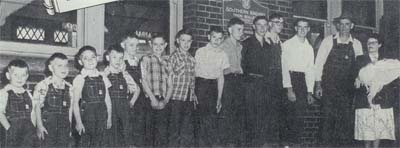 |
|---|
The Harrison Family Boards for New York - 1955 |
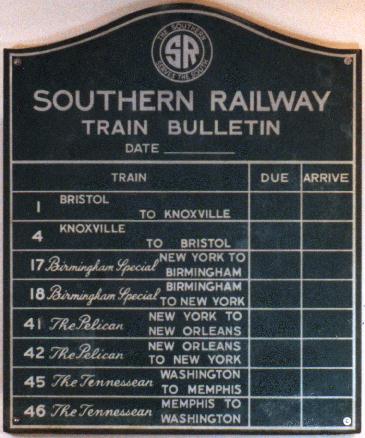 |
|
|
Southern Railway Arrival and Departure Board |
|
Southern Depot - Johnson City (South View) |
|
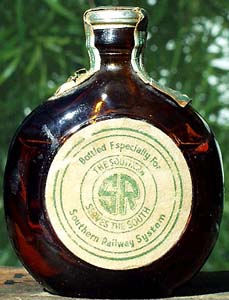 |
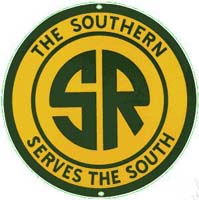 |
Southern Railway Hospitality |
Southern Railway Sign |
|
|||||||||||||||||||||||||||||||||||||||||||||||
|
|||||||||||||||||||||||||||||||||||||||||||||||
|
Links
|
|||||||||||||||||||||||||||||||||||||||||||||||
